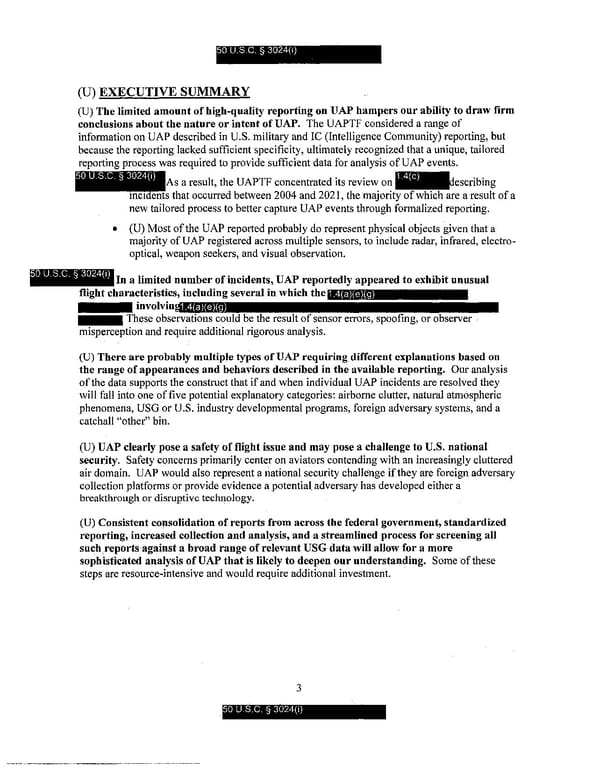50 U.S.C. § 3024(i) (U) EXECUTIVE SUMMARY (U) The limited amount of high-quality reporting on UAP hampers our ability to draw firm conclusions about the nature or intent of UAP. The UAPTP considered a range of information on UAP described in U.S. military and IC (Intelligence Community) reporting, but because the reporting lacked sufficient specificity, ultimately recognized that a unique, tailored reporting process was required to provide sufficient data for analysis ofUAP events. 50 U.S.C. § 3024(i) As a result, the UAPTP concentrated its review on ~escribing InCIdents that occurred between 2004 and 2021, the majority of which are a result of a new tailored process to better capture UAP events through formalized reporting. 50 U.S.C. § 3024(i) • (U) Most of the UAP reported probably do represent physical objects given that a majority of UAP registered across multiple sensors, to include radar, infrared, electro- optical, weapon seekers, and visual observation. In a limited number of incidents, UAP reportedly appeared to exhibit unusual flight characteristics, including several in which the 1.4(a)( e )(g) ~1.4(a)(e)(g) ,==" involvin • These observations could be the result of sensor errors, spoofing, or observer . misperception and require additional rigorous analysis. (U) There are probably multiple types ofUAP requiring different explanations based on the range of appearances and behaviors described in the available reporting. Our analysis of the data supports the construct that if and when individual UAP incidents are resolved they will fall into one offive potential explanatory categories: airborne clutter, natural atmospheric phenomena, USG or U.S. industry developmental programs, foreign adversary systems, and a catchall "other" bin. (U) UAP clearly pose a safety of flight issue and may pose a challenge to U.S. national security. Safety concerns primarily center on aviators contending with an increasingly cluttered air domain. UAP would also represent a national security challenge if they are foreign adversary collection platforms or provide evidence a potential adversary has developed either a breakthrough or disruptive technology. (U) Consistent consolidation of reports from across the federal government, standardized reporting, increased collection and analysis, and a streamlined process for screening all such reports against a broad range of relevant USG data will allow for a more sophisticated analysis ofUAP that is likely to deepen our understanding. Some of these steps are resource-intensive and would require additional investment. 3 50 U.S.C. § 3024(i)
 Unidentified Aerial Phenomena | NI Report Page 9 Page 11
Unidentified Aerial Phenomena | NI Report Page 9 Page 11